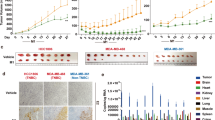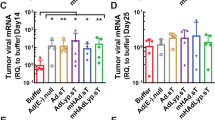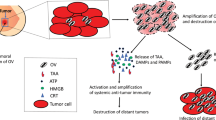Abstract
Tumor necrosis factor-related apoptosis-inducing ligand (TRAIL) gene therapy and oncolytic adenovirotherapy have been investigated extensively in xenografic human tumor models established in immunocompromised nude mice. However, the effects of these therapies on syngeneic murine tumors in immunocompetent settings were not well documented. We hypothesized that TRAIL gene therapy used with an oncolytic adenovirus would overcome the weaknesses of the two therapies used individually. In this study, we evaluated the antitumor effects of an oncolytic adenovirus, Delta24, in both human and murine breast cancer cell lines. We also analyzed the effects of TRAIL gene therapy combined with oncolytic virotherapy in these cancer cells. Our results showed that Delta24 can replicate and help the E1-deleted adenovector replicate in murine cancer cells. We also found that these two therapies combined had greater antitumor activity than either one alone in both human and murine breast cancer cells lines and in the syngeneic breast cancer models established in immunocompetent mice. Moreover, Delta24 virotherapy alone and combined with TRAIL gene therapy dramatically reduced the spontaneous liver metastasis that originated in the subcutaneous 4T1 tumor established in Balb/c mice. These findings provide important considerations in the development and preclinical assessments of oncolytic virotherapy.
This is a preview of subscription content, access via your institution
Access options
Subscribe to this journal
Receive 12 print issues and online access
$259.00 per year
only $21.58 per issue
Buy this article
- Purchase on Springer Link
- Instant access to full article PDF
Prices may be subject to local taxes which are calculated during checkout





Similar content being viewed by others
References
Anonymous. Recent trends in mortality rates for four major cancers by sex and race/ethnicity – United States 1990–1998. MMWR 2002; 51: 49–53.
Seltzer V . Cancer in women: prevention and early detection. J Womens Health Gender Based Med 2000; 9: 483–488.
Fueyo J, Gomez-Manzano C, Alemany R, Lee PS, McDonnell TJ, Mitlianga P et al. A mutant oncolytic adenovirus targeting the Rb pathway produces anti-glioma effect in vivo. Oncogene 2000; 19: 2–12.
Fueyo J, Alemany R, Gomez-Manzano C, Fuller GN, Khan A, Conrad CA et al. Preclinical characterization of the antiglioma activity of a tropism-enhanced adenovirus targeted to the retinoblastoma pathway. J Natl Cancer Inst 2003; 95: 652–660.
Jacob D, Davis J, Zhu H, Zhang L, Teraishi F, Wu S et al. Suppressing orthotopic pancreatic tumor growth with a fiber-modified adenovector expressing the TRAIL gene from the human telomerase reverse transcriptase promoter. Clin Cancer Res 2004; 10: 3535–3541.
Kagawa S, Gu J, Swisher SG, Ji L, Roth JA, Lai D et al. Antitumor effect of adenovirus-mediated Bax gene transfer on p53-sensitive and p53-resistant cancer lines. Cancer Res 2000; 60: 1157–1161.
Ginsberg HS, Moldawer LL, Sehgal PB, Redington M, Kilian PL, Chanock RM et al. A mouse model for investigating the molecular pathogenesis of adenovirus pneumonia. Proc Natl Acad Sci USA 1991; 88: 1651–1655.
Wang Y, Hallden G, Hill R, Anand A, Liu TC, Francis J et al. E3 gene manipulations affect oncolytic adenovirus activity in immunocompetent tumor models. Nat Biotechnol 2003; 21: 1328–1335.
Lin T, Gu J, Zhang L, Huang X, Stephens LC, Curley SA et al. Targeted expression of green fluorescent protein/tumor necrosis factor-related apoptosis-inducing ligand fusion protein from human telomerase reverse transcriptase promoter elicits antitumor activity without toxic effects on primary human hepatocytes. Cancer Res 2002; 62: 3620–3625.
Lin T, Huang X, Gu J, Zhang L, Roth JA, Xiong M et al. Long-term tumor-free survival from treatment with the GFP-TRAIL fusion gene expressed from the hTERT promoter in breast cancer cells. Oncogene 2002; 21: 8020–8028.
Kagawa S, He C, Gu J, Koch P, Rha SJ, Roth JA et al. Antitumor activity and bystander effects of the tumor necrosis factor-related apoptosis-inducing ligand (TRAIL) gene. Cancer Res 2001; 61: 3330–3338.
Jiang H, Alemany R, Gomez-Manzano C, Alemany R, Medrano D, Alonso M et al. Comparative effect of oncolytic adenoviruses with E1A-55 kDa or E1B-55 kDa deletions in malignant gliomas. Neoplasia 2005; 1: 48–56.
Hallden G, Hill R, Wang Y, Anand A, Liu TC, Lemoine NR et al. Novel immunocompetent murine tumor models for the assessment of replication-competent oncolytic adenovirus efficacy. Mol Ther 2003; 8: 412–424.
Zhu H, Zhang L, Huang X, Davis JJ, Jacob DA, Teraishi F et al. Overcoming acquired resistance to TRAIL by chemotherapeutic agents and calpain inhibitor I through distinct mechanisms. Mol Ther 2004; 9: 666–673.
Botos J, Smith III R, Kochevar DT . Retinoblastoma function is a better indicator of cellular phenotype in cultured breast adenocarcinoma cells than retinoblastoma expression. Exp Biol Med (Maywood) 2002; 227: 354–362.
Cheng L, Rossi F, Fang W, Mori T, Cobrinik D . Cdk2-dependent phosphorylation and functional inactivation of the pRB-related p130 protein in pRB(−), p16INK4A(+) tumor cells. J Biol Chem 2000; 39: 30317–30325.
Chang YC, Illenye S, Heintz NH . Cooperation of E2F-p130 and Sp1-pRb complexes in repression of the Chinese hamster dhfr gene. Mol Cell Biol 2001; 4: 1121–1131.
Hurford Jr RK, Cobrinik D, Lee MH, Dyson N . pRB and p107/p130 are required for the regulated expression of different sets of E2F responsive genes. Genes Dev 1997; 11: 1447–1463.
Burroughs KD, Kayda DB, Sakhuja K, Hudson Y, Jakubczak J, Bristol JA et al. Potentiation of oncolytic adenoviral vector efficacy with gutless vectors encoding GMCSF or TRAIL. Cancer Gene Ther 2004; 11: 92–102.
Pei Z, Chu L, Zou W, Zhang Z, Qiu S, Qi R et al. An oncolytic adenoviral vector of Smac increases antitumor activity of TRAIL against HCC in human cells and in mice. Hepatology 2004; 39: 1371–1381.
Sova P, Ren XW, Ni S, Bernt KM, Mi J, Kiviat N et al. A tumor-targeted and conditionally replicating oncolytic adenovirus vector expressing TRAIL for treatment of liver metastases. Mol Ther 2004; 9: 496–509.
Hiraga T, Ueda A, Tamura D, Hata K, Ikeda F, Williams PJ et al. Effects of oral UFT combined with or without zoledronic acid on bone metastasis in the 4T1/luc mouse breast cancer. Int J Cancer 2003; 106: 973–979.
Lee EY, To H, Shew JY, Bookstein R, Scully P, Lee WH . Inactivation of the retinoblastoma susceptibility gene in human breast cancers. Science 1988; 241: 218–221.
Harkes IC, Elstrodt F, Dinjens WN, Molier M, Klijn JG, Berns EM et al. Allelotype of 28 human breast cancer cell lines and xenografts. Br J Cancer 2003; 89: 2289–2292.
Padalecki SS, Guise TA . Actions of bisphosphonates in animal models of breast cancer. Breast Cancer Res 2002; 4: 35–41.
Yoneda T, Michigami T, Yi B, Williams PJ, Niewolna M, Hiraga T . Actions of bisphosphonate on bone metastasis in animal models of breast carcinoma. Cancer 2000; 88: 2979–2988.
Acknowledgements
We thank Henry Peng and Li Wang for propagating the adenovirus and conducting the vector quality test, Alma J Vega for helping prepare the manuscript, and Gayle Nesom for reviewing the manuscript. This article represents the partial fulfillment of the requirements for a PhD for JJ Davis. This work was supported in part by National Cancer Institute grants RO1 CA 092487-01A1 (to B Fang), RO1 CA 098582-01A1 (to B Fang), and CA-16672 and by the Lockton grant-matching fund.
Author information
Authors and Affiliations
Corresponding author
Rights and permissions
About this article
Cite this article
Guo, W., Zhu, H., Zhang, L. et al. Combination effect of oncolytic adenovirotherapy and TRAIL gene therapy in syngeneic murine breast cancer models. Cancer Gene Ther 13, 82–90 (2006). https://doi.org/10.1038/sj.cgt.7700863
Received:
Revised:
Accepted:
Published:
Issue Date:
DOI: https://doi.org/10.1038/sj.cgt.7700863
Keywords
This article is cited by
-
Combinatorial treatment with oncolytic adenovirus and helper-dependent adenovirus augments adenoviral cancer gene therapy
Molecular Therapy - Oncolytics (2014)
-
Intravenous administration of adenoviruses targeting transforming growth factor beta signaling inhibits established bone metastases in 4T1 mouse mammary tumor model in an immunocompetent syngeneic host
Cancer Gene Therapy (2012)
-
Analysis of adenovirus trans-complementation-mediated gene expression controlled by melanoma-specific TETP promoter in vitro
Virology Journal (2010)
-
Second-generation HIF-activated oncolytic adenoviruses with improved replication, oncolytic, and antitumor efficacy
Gene Therapy (2010)
-
TRAIL gene-armed oncolytic poxvirus and oxaliplatin can work synergistically against colorectal cancer
Gene Therapy (2010)



